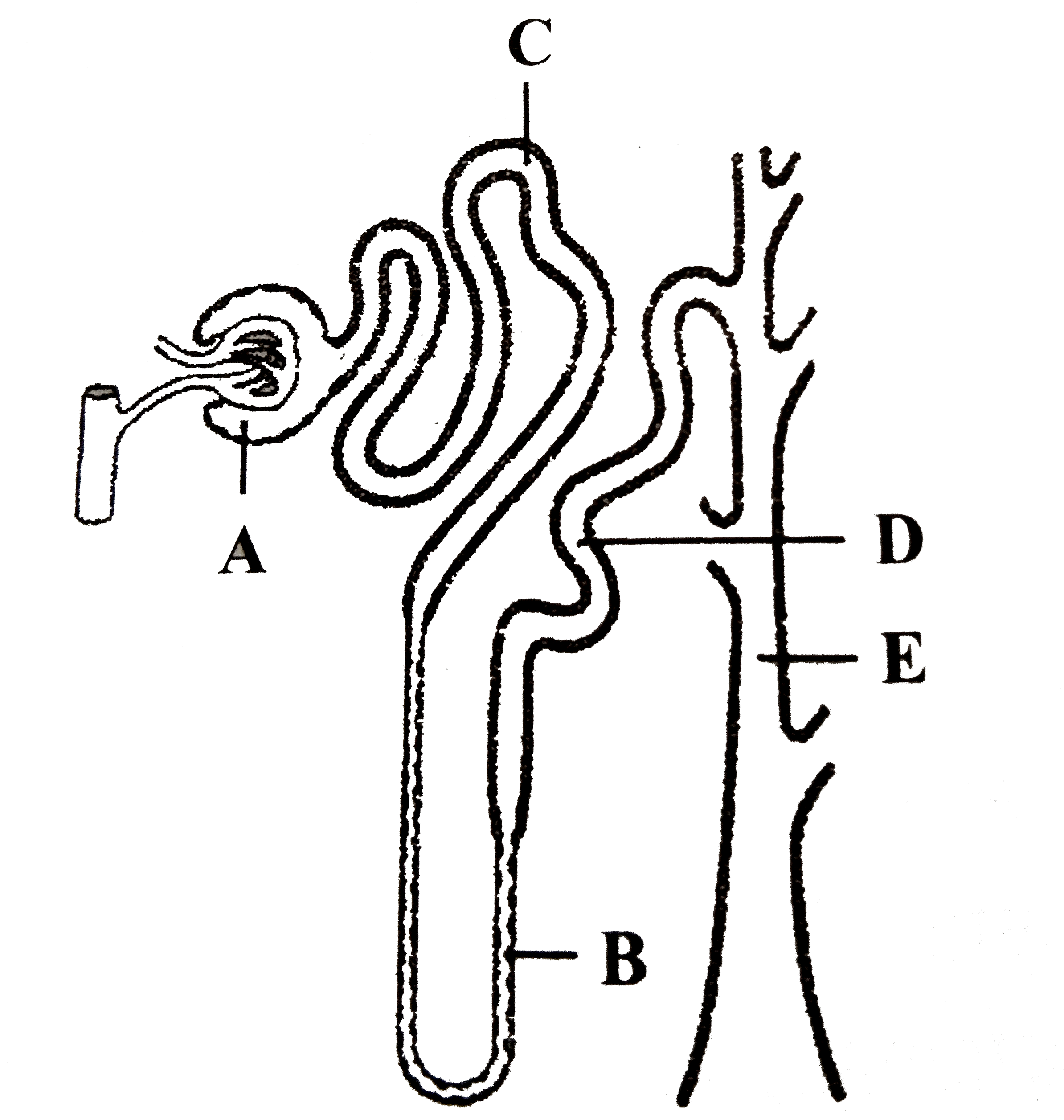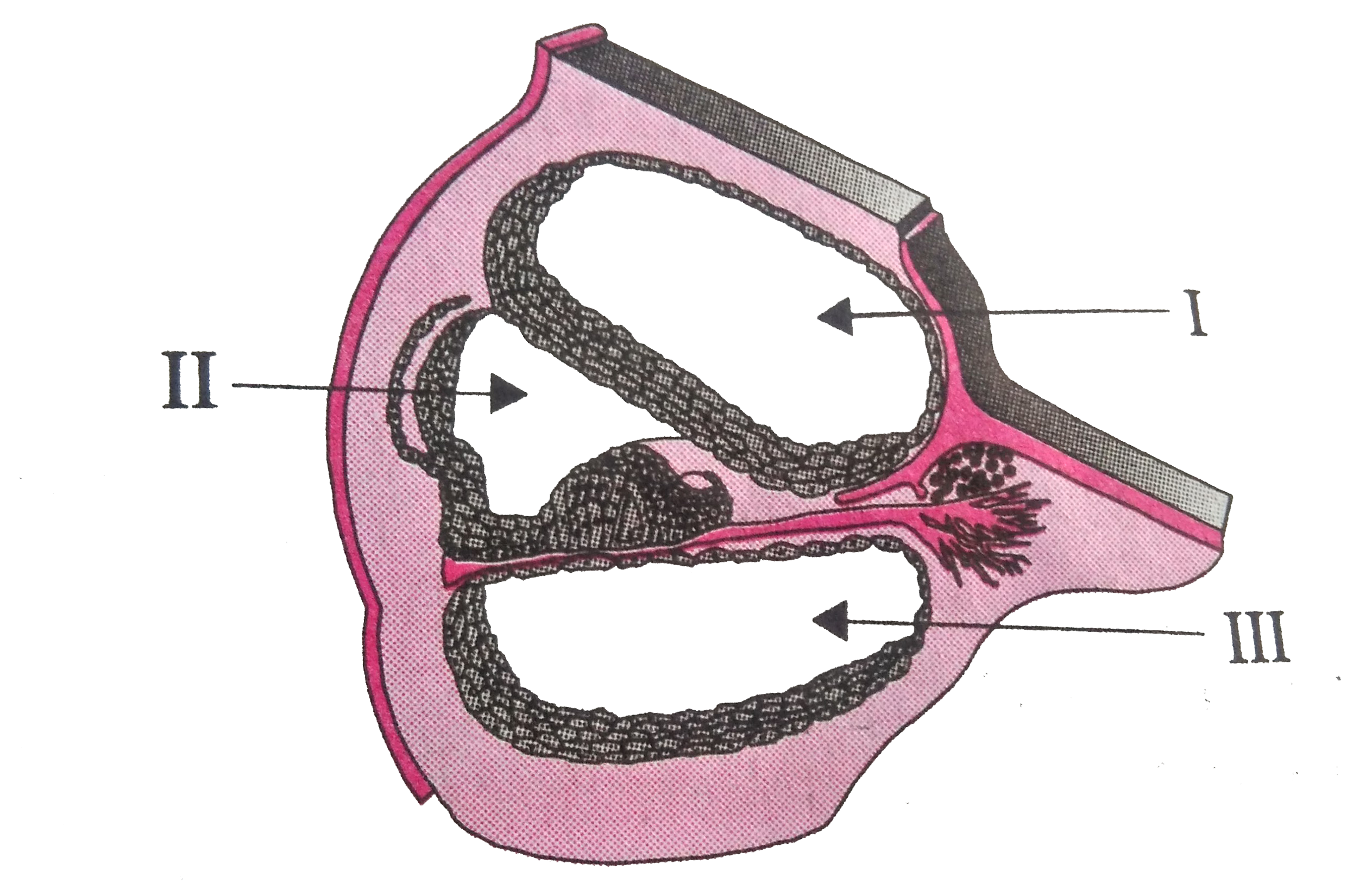Select the correct option representing the parts of nephron that respectively absorb (i).______ glucose, (ii)._____amino acids,
(iii).______inorganic ions (Na+,K+,Cl−) and (iv).____urea in maximum.
(i)(ii)(iii)(iv)DCTDescending limb of loop of HenleDCTDCT
(i)(ii)(iii)(iv)DCTDescending limb of loop of HenlePCTDCT
(i)(ii)(iii)(iv)PCTPCTPCTAscending lib of loop of Henle
(i)(ii)(iii)(iv)PCTDCTDCTAscending limb of loop of Henle
The correct Answer is:C
To solve the question regarding the parts of the nephron that absorb glucose, amino acids, inorganic ions, and urea, we can follow these steps:
1. Identify the Function of Nephron Parts:
- The nephron is the functional unit of the kidney and is responsible for filtering blood and reabsorbing essential substances.
2. Glucose Absorption:
- Glucose is primarily reabsorbed in the Proximal Convoluted Tubule (PCT). This is where the majority of glucose reabsorption occurs through active transport mechanisms.
3. Amino Acids Absorption:
- Similar to glucose, amino acids are also reabsorbed in the Proximal Convoluted Tubule (PCT). The reabsorption of amino acids occurs alongside glucose through specific transport proteins.
4. Inorganic Ions Absorption:
- Inorganic ions such as sodium (Na⁺), potassium (K⁺), and chloride (Cl⁻) are predominantly reabsorbed in the Proximal Convoluted Tubule (PCT). Some reabsorption also occurs in other parts of the nephron, but the maximum occurs in the PCT.
5. Urea Absorption:
- Urea is reabsorbed mainly in the Ascending Limb of the Loop of Henle. This part of the nephron allows for the passive reabsorption of urea, contributing to the concentration of urine.
6. Compile the Answers:
- Therefore, the correct parts of the nephron that absorb the substances in maximum amounts are:
- (i) Glucose: PCT
- (ii) Amino Acids: PCT
- (iii) Inorganic Ions: PCT
- (iv) Urea: Ascending Limb of Loop of Henle
Final Answer:
The correct option representing the parts of nephron that respectively absorb:
(i) Glucose: PCT,
(ii) Amino Acids: PCT,
(iii) Inorganic Ions: PCT,
(iv) Urea: Ascending Limb of Loop of Henle.
- The nephron is the functional unit of the kidney and is responsible for filtering blood and reabsorbing essential substances.
- Glucose is primarily reabsorbed in the Proximal Convoluted Tubule (PCT). This is where the majority of glucose reabsorption occurs through active transport mechanisms.
- Similar to glucose, amino acids are also reabsorbed in the Proximal Convoluted Tubule (PCT). The reabsorption of amino acids occurs alongside glucose through specific transport proteins.
- Inorganic ions such as sodium (Na⁺), potassium (K⁺), and chloride (Cl⁻) are predominantly reabsorbed in the Proximal Convoluted Tubule (PCT). Some reabsorption also occurs in other parts of the nephron, but the maximum occurs in the PCT.
- Urea is reabsorbed mainly in the Ascending Limb of the Loop of Henle. This part of the nephron allows for the passive reabsorption of urea, contributing to the concentration of urine.
- Therefore, the correct parts of the nephron that absorb the substances in maximum amounts are:
- (i) Glucose: PCT
- (ii) Amino Acids: PCT
- (iii) Inorganic Ions: PCT
- (iv) Urea: Ascending Limb of Loop of Henle
The correct option representing the parts of nephron that respectively absorb:
(i) Glucose: PCT,
(ii) Amino Acids: PCT,
(iii) Inorganic Ions: PCT,
(iv) Urea: Ascending Limb of Loop of Henle.
Topper's Solved these Questions
- BOOK - NCERT FINGERTPS ENGLISHCHAPTER - EXCRETORY PRODUCTS AND THEIR ELIMINATIONEXERCISE - Assertion & Reason15videos
EXCRETORY PRODUCTS AND THEIR ELIMINATION
- BOOK - NCERT FINGERTPS ENGLISHCHAPTER - EXCRETORY PRODUCTS AND THEIR ELIMINATIONEXERCISE - Excretory Products And Their Elimination133videos
EXCRETORY PRODUCTS AND THEIR ELIMINATION
- BOOK - NCERT FINGERTPS ENGLISHCHAPTER - DIGESTION AND ABSORPTIONEXERCISE - Digestion And Absorption137videos
DIGESTION AND ABSORPTION
- BOOK - NCERT FINGERTPS ENGLISHCHAPTER - LOCOMOTION AND MOVEMENTEXERCISE - Locomotion And Movement139videos
LOCOMOTION AND MOVEMENT
Similar Questions
Knowledge Check
- Question 1 - Select One
Select the correct option representing the excretory organs present in (i) earthworm, (ii) centipede, (iii) prawn, and (iv) flatworm.
A(i)(ii)(iii)(iv)Malpighian tubulesFlame cellNephridiaGreen glandsB(i)(ii)(iii)(iv)Flame cellGreen glandMalpighian tubulesNephridiaC(i)(ii)(iii)(iv)NephridiaMalpighian tubulesGreen glandFlame cellD(i)(ii)(iii)(iv)Green glandNephridiaFlame cellMalpighian - Question 2 - Select One
Select the correct option, among Sc(III) , Ti(IV), Pd(II) and Cu(II) ions
Aall are paramagneticBall are diamagneticCSc(III), Ti(IV) are paramagnetic and Pd(III), Cu(II) are diamagneticDSc(III), Ti(IV) are diamagnetic and Pd(II), Cu(II) are paramagnetic. - Question 3 - Select One
Select the correct option that represents examples of the following types of animals.
(i) Cold blooded animal
(ii) Warm blooded animal
(iii) Animal possessing dry and cornified skin
(iv) Hermaphrodite animal.A(i) (ii) (iii) (iv)Forg Pigeon Wall lizard EarthwormB(i) (ii) (iii) (iv)Pigeon Frog Crocodile HydraC(i) (ii) (iii) (iv)Rabbit Fish Frog EarthwormD(i) (ii) (iii) (iv)Fish Frog wall lizard Starfish
Select the correct option that represents examples of the following types of animals.
(i) Roundworm
(ii) Fish possessing poison string
(iii) A limbless amphibian
(iv) An oviparous mammalView SolutionFill up the blanks in the following paragraph by selecting the correct option. Small amounts of monosaccharides like glucose, amino acids and some of electrolytes like chloride ions are absorbed by (i). However, some of the substances like fructose and some amino acids are absorbed by the mechanism called the (ii). Various nutrients like amino acids and electrolytes like Na+ are absorbed into the blood by (iii).
View Solutionwhich of the following molecules are absorbed by only passive transport in small intestine?
1) glucose
2) amino acids
3) Na^+ ions
4) waterView SolutionMatch the column I,II,and III .Select the correct option :
 View Solution
View Solution
The given figure represents a single nephron from a mammalian kidney. Identify the labelled parts, match them with the functions (i-iv) and select the correct option.
(i). The site of ultrafiltration.
(ii). Particularly sensitive to ADH.
(iii). The main site for the reabsorption of glucose and amino acids.
(iv). Largely responsible for the maintenance of blood pH.View Solution



